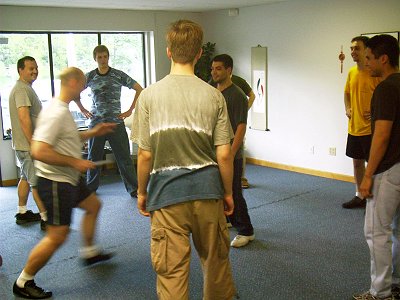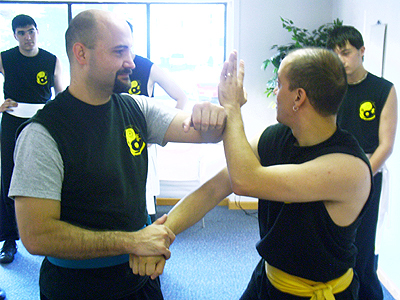its paid sponsors, whose products you need!
“Stay ‘unreasonable.’ If you
don’t like the solutions [available to you], come up with your
own.”
Dan Webre
The Martialist does not
constitute legal advice. It is for ENTERTAINMENT
PURPOSES ONLY.
Copyright © 2003-2004 Phil Elmore, all rights
reserved.
The Circle of Death as Training Tool
By Phil Elmore
“Okay, Circle,” my
Wing Chun
teacher, Sifu Anthony Iglesias, will say in class. If he calls the
exercise by its full and somewhat whimsical name the “Circle of Death” it
prompts the obligatory class joke.
“I don’t know, Anthony,” I will say. “We
lost two students last week.” (Alternatively, the punchline can go, “You
know what happened last time…” The key is the right deadpan,
dubious tone.)
Kidding aside, the “Circle of Death” is one of
the best martial arts training tools I’ve experienced. The pace and the
nature of the exercise are easily controlled, it requires no resources, and
students benefit from working with the full diversity of training partners
available in class.
Sifu Anthony Iglesias (right)
demonstrates a chi sao technique.
The typical Circle of Death is a loose circle
of all the students arranged about the perimeter of the training area. A
direction for moving around the Circle is chosen; we’ll assume clockwise
for purposes of this article. The first student enters the center of the
Circle and turns to face the classmate who was standing to his or her left.
The classmate attacks and the student at the
center of the Circle of Death defends against that attack. The student
then turns to face the next classmate in the Circle, who attacks. The
cycle repeats until the student again faces his or her first “attacker,” at
which point the two exchange places. The new student in the center faces
the next classmate in the rotation and the pattern begins again.
This simple drill framework is almost
limitlessly adaptable to the instructor’s training goals. For example,
if the teacher wishes to focus on and emphasize entering techniques, the
students could be instructed to attack from within the center,
initiating techniques rather than defending against them. If a specific
principle is to be trained say, moving off the attacking line the
instructor can restrict the techniques used or specify required responses.
“When attacked,” the teacher might stipulate, “do not use hand techniques.
Use only footwork to evade the incoming strike.” Alternatively, he or
she could make demands: “When you counterattack I want to see you strike
your opponent at least five times.”
Hands-on instruction is essential to
getting the most
from Circle of Death drills.
Circle of Death training can be completely
free-form. In this, students attack with punches, kicks, or shoots and
defenders do whatever they wish to preempt, meet, or counter the attack.
Training can also be used to drill specific techniques learned earlier in
class. Training free-form is a superb substitute for sparring, which can
ingrain bad habits (such as pulling punches) and is done from an unrealistic
“dueling” standpoint. Effective self-defense more closely and more often
resembles a sudden attack with which the defender must cope. Compare
this to the squared-off contest of sparring partners and the difference is
clear.
Combat drills within the Circle of Death permit
more realistic contact, too, in that the abbreviated exchange is less risky
than the sometimes reckless interaction of sparring. This is
particularly true of lower-level students, who often have more enthusiasm than
control. All students must still use caution, of course, but they can go
“harder” knowing the parameters of each brief “match” within the Circle.
When using the Circle of Death to drill
specific techniques, the advantages of this format manifest themselves in
mandating a variety of training partners. Students tend to form cliques,
or at the very least are predisposed to work with (or avoid) those training
partners with whom they are more familiar. This is natural, but becoming
too accustomed to fighting a person of a certain size, or who can be expected
to attack a certain way, again ingrains bad habits and limits the student’s
training.
The instructor can deal with this issue by
assigning partners and switching those partners at command, but this can
become tiresome and even unworkable with large classes. The Circle of
Death, by design, requires complete variety of available partners, for each
student at the Circle’s center has no choice but to work with each and every
classmate.
Sifu Iglesias demonstrates a
technique using the wooden dummy
to illustrate before having the students practice in the Circle of Death.
Another benefit of the Circle of Death training
format is that it can be used to control pacing easily. The instructor
can verbally prod each successive student to attack, for example, or simply
encourage all participants to initiate their turns as quickly as possible.
This leads to a very fast-paced, demanding session in which the student in the
center must develop quick reflexes and has no time to rest or become
complacent.
Adjusting the pace of the drill teaches the
need for proper focus and concentration, too. During one intensive
evening of the Circle of Death, my instructor taking a turn in the center
himself got tagged by an attacking student. “I daydreamed and got
hit,” he warned us. “You must have the proper mindset when you’re
in the Circle.”
Permutations of Circle of Death training are
limited only by the instructor’s imagination. Any training can be done
in this format with slight adjustments. Students can practice specific
punches or kicks while the center occupant performs specific defenses, or each
pairing could culminate in a quick grappling match or defense against a
specific groundfighting technique. The classmates in the perimeter could
pass a training gun from person to person and the center student could
practice gun defenses and disarms. The Circle of Death is really just an
organized tool for matching students and controlling the speed with which they
interact.
One wrinkle Sifu Iglesias has introduced in the
past is my favorite. On occasion he will pass rubber training knives
around the Circle. He did this once without my knowledge while I was in
the center, using a variety of Wing Chun techniques to defend against incoming
blows and shoots.
I am very nearsighted. Wing Chun is
perfectly tailored to my needs, for it is built on the development of touch-go
reflexes (practiced through “chi sao” or “sticky hands” drills) that emphasize
fighting by feel rather than by sight. I often train with my
glasses off because I’ve had them knocked from my face more than once.
To be dependent on them for effective fighting would be disastrous, so I fight
without them as often as not. What this means, however, is that I cannot
see a rubber knife in an opposing student’s hand until it is close enough to
“cut” me.

The “Circle of Death” during an
informal SWCA knife-defense seminar.
When the knives magically appeared during that
Circle of Death, it was a sobering reminder to treat every attack as if
the attacker could have a deadly weapon you cannot see. (This is, of
course, very applicable to real-world self-defense, as many attackers will not
brandish a knife to warn you that it is coming.)
Any school with a handful of students on hand
can host the Circle of Death. This is a simple tool, a drill framework
that can be tailored to the instructor’s requirements and adapted constantly
to new goals and circumstances. If you are a teacher and you aren’t
using this method, I encourage you to try it. If you are a student and
your instructor doesn’t employ this drill, you might want to suggest it.
Constructive training should be challenging, goal-oriented,
realistic, and fun.
The Circle of Death promotes all of these.




